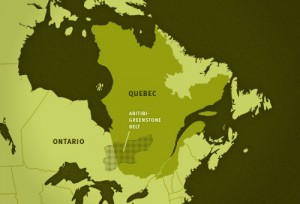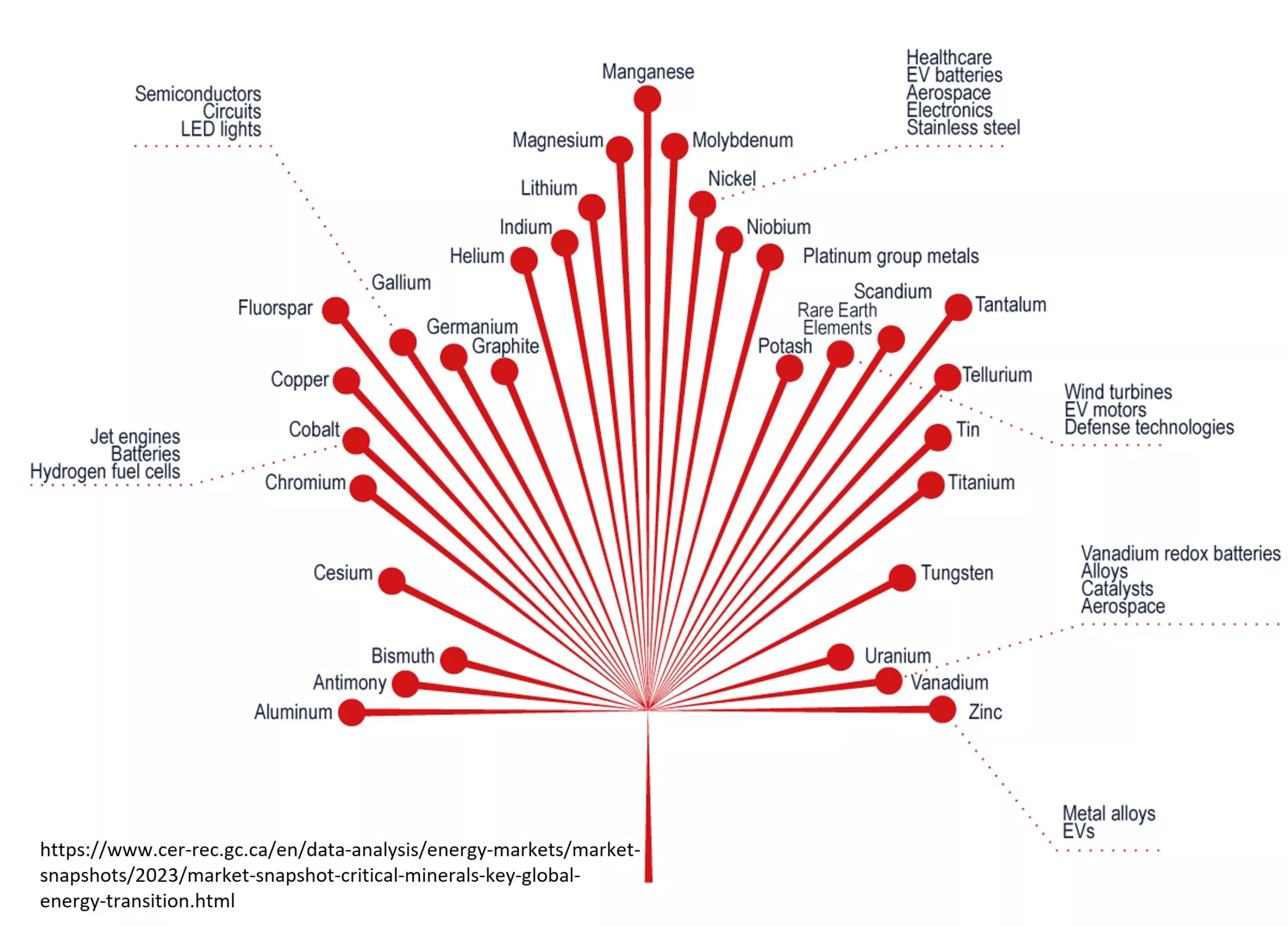Overview
Several of the world’s largest gold and base metal deposits are found in eastern Canada’s Abitibi greenstone belt (AGB). The term world-class can sometimes be overused, but the AGB really earns the title, hosting 11 gold deposits over 100 tonnes, including one of the biggest deposits in the world, the >1000 t gold Hollinger-McIntyre deposits near Timmins, Ontario.
 Location
Location
The AGB is a 150 km wide greenstone belt that stretches for 650 km across Eastern Canada, from Wawa, Ontario in the west to Val d’Or, Quebec in the east.
The area has produced over 180,000,000 ounces of gold and more than 450,000,000 tons of Cu-Zn ore since the early 1900’s.
About one third on the belt is in the province of Ontario with the remaining two-thirds in Quebec.
Creating a monster
The AGB is made of volcanic and sedimentary rocks laid down in the Archean era over 2500 million years ago.
Before the formation of the continents and oceans we see today, several active volcanoes spewed out huge volumes of mafic and felsic lava and ash over millions of years.
There were about seven periods of volcanic activity and during the pauses in between, sediments were deposited in shallow seas.
This package of volcanic and sedimentary rocks has since been compressed, deformed and intruded by igneous rocks.
Driven by plate tectonics, the rocks were compressed in an area where one plate was being forced under another, at a convergent plate boundary.
Heated and compressed several kilometers below the surface, these rocks underwent a “low-grade” metamorphism: Metamorphic rocks are created when the original sedimentary or igneous rock are changed through heat and pressure over a long period of time. A “low-grade” metamorphic rock is one that has been altered from it’s original parent rock by low to moderate increases in temperature and pressure. The metamorphic grade throughout the belt is generally classified by geologists as “greenschist”, resulting in a suite of green-coloured minerals, including chlorite, actinolite and epidote.
This deformation in the upper crust created features known as shear zones, where huge blocks of rock strain against each other along slippery boundaries. These shear zones provided important pathways for the fluids responsible for the rich mineral deposits mined today.
Many of the richest deposits in the AGB are spread along two major shear zones: the Porcupine Destor Deformation Zone and the Cadillac-Larder Lake Deformation Zone.
Exploration and discovery
Prospectors have been wandering around the AGB since 1907. Gold was first discovered in 1917 at the site of the present-day Holt-McDermott mine.
Exploration has continued with varying levels of enthusiasm ever since. Most of the deposits mined today were discovered in the early 20th century by classic exploration techniques involving drill testing of targets identified by geophysical (electromagnetic) surveys.
The discovery of new mines in the late 1990’s, including the Holloway Mine, sparked a renewed interest in the region that continues today.
New discoveries will likely be found much deeper than the current deposits. They will be located using modern geophysical and geochemical techniques developed to see through the thick overburden of glacial sediments that cover the surface of the AGB.
Deposit types and some important mines
The three main deposit types found in the AGB are:
- Volcanic hosted massive sulfide (VHMS) deposits, such as the rich Rouyn-Noranda district in Quebec, and at Kidd Creek, north of Timmins, Ontario.
- Gold-rich VHMS deposits, such as the LaRonde Penna mines in Quebec
- Orogenic gold deposits, such as the Hollinger-McIntyre and Dome mines, and 7km-long string of Kirkland Lake deposits near Timmins, Ontario, and the Sigma-Lamaque complex in Quebec.
Canada’s largest gold mine, the world-class Malartic gold mine, is expected to produce well over 500,000 ounces of gold per year until 2028.

Recent activity around the AGB
Exploration and mine expansion projects have the AGB buzzing with activity in recent years due to better metal prices, increased activity and productivity gains through improved mining technologies. A few junior explorers that have been active recently include;
- Falco Resources, who are chasing a promising geophysical anomaly with drilling at its Lac Hervé property
- Metanor, who are working to expand and define mineralization at the Bachelor Lake Mine
- Kirkland Lake Gold, who were drilling exploration holes on their Macassa Property in the southern AGB earlier this year
- Harte Gold, who got some nice results from an IP survey on their Sugar Zone property near the Hemlo gold mines.
Further reading
A Special Issue of Economic Geology from 2008 is devoted to Base Metal and Gold Metallogeny at Regional, Camp, and Deposit Scales in the Abitibi Greenstone Belt. The Preface provides a rich overview.
Porter GeoConsultancy has a searchable database with lots of detail about the individual deposits mentioned in this article.
Various resources from the Ontario and Quebec Geological Surveys, including this open file report: Structural Geology of the Holloway Mine, Abitibi Greenstone Belt, Ontario
Formation of the Abitibi greenstone belt by arc-trench migration in Geology
Subscribe for Email Updates










. @KlondikeStrike time to shutter that POS. No one wants #gold anymore. It’s going to be free. Just ask #JPMorgan @CNBC
Your headline picture caption indicates that this is a picture of Kirkland Lake gold deposits. This is actually a picture of Kidd Mine, easily identifiable with its two concrete headframes and it’s adjacent pit.
Thanks. Photo updated.